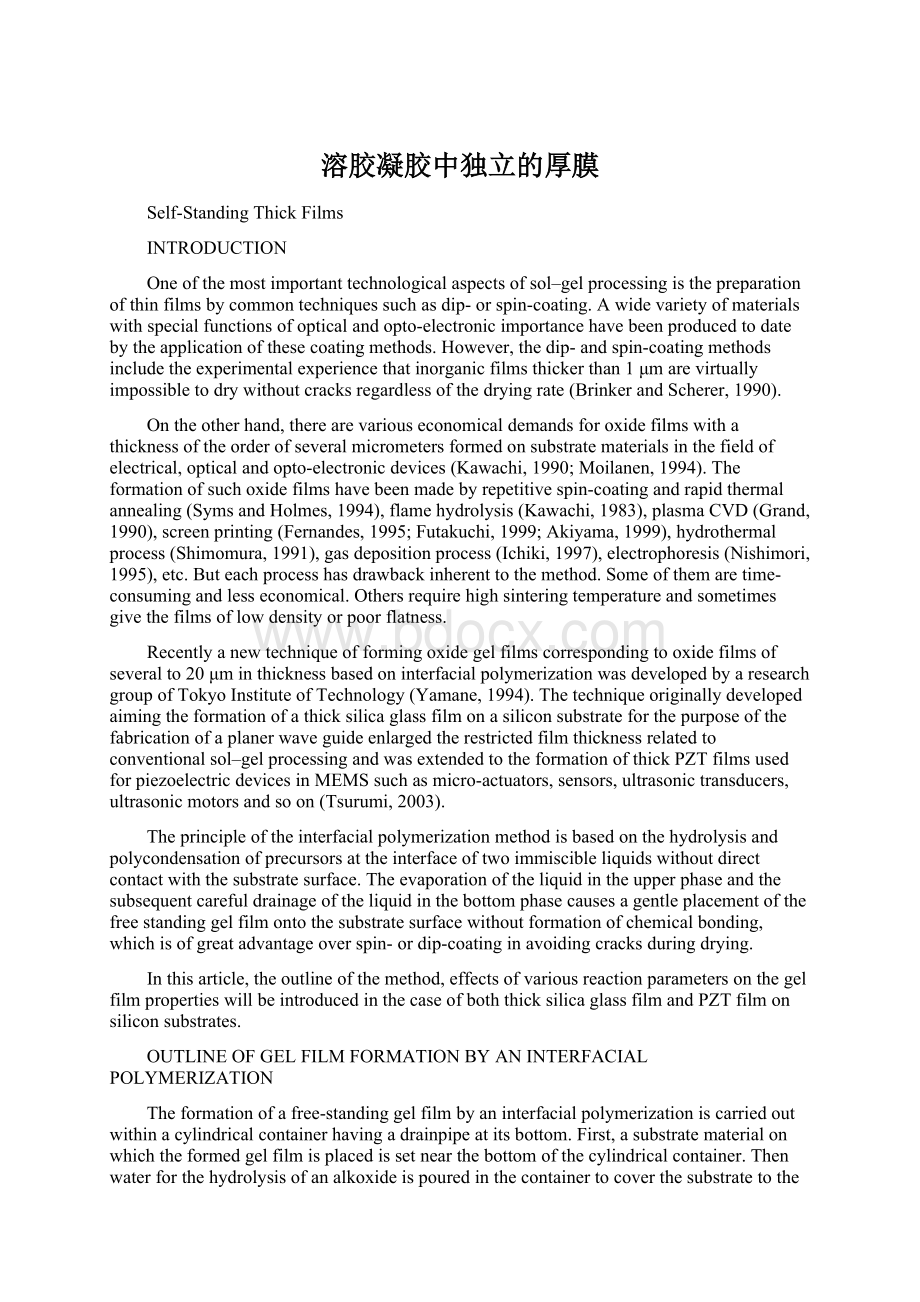溶胶凝胶中独立的厚膜文档格式.docx
《溶胶凝胶中独立的厚膜文档格式.docx》由会员分享,可在线阅读,更多相关《溶胶凝胶中独立的厚膜文档格式.docx(10页珍藏版)》请在冰豆网上搜索。

Recentlyanewtechniqueofformingoxidegelfilmscorrespondingtooxidefilmsofseveralto20μminthicknessbasedoninterfacialpolymerizationwasdevelopedbyaresearchgroupofTokyoInstituteofTechnology(Yamane,1994).Thetechniqueoriginallydevelopedaimingtheformationofathicksilicaglassfilmonasiliconsubstrateforthepurposeofthefabricationofaplanerwaveguideenlargedtherestrictedfilmthicknessrelatedtoconventionalsol–gelprocessingandwasextendedtotheformationofthickPZTfilmsusedforpiezoelectricdevicesinMEMSsuchasmicro-actuators,sensors,ultrasonictransducers,ultrasonicmotorsandsoon(Tsurumi,2003).
Theprincipleoftheinterfacialpolymerizationmethodisbasedonthehydrolysisandpolycondensationofprecursorsattheinterfaceoftwoimmiscibleliquidswithoutdirectcontactwiththesubstratesurface.Theevaporationoftheliquidintheupperphaseandthesubsequentcarefuldrainageoftheliquidinthebottomphasecausesagentleplacementofthefreestandinggelfilmontothesubstratesurfacewithoutformationofchemicalbonding,whichisofgreatadvantageoverspin-ordip-coatinginavoidingcracksduringdrying.
Inthisarticle,theoutlineofthemethod,effectsofvariousreactionparametersonthegelfilmpropertieswillbeintroducedinthecaseofboththicksilicaglassfilmandPZTfilmonsiliconsubstrates.
OUTLINEOFGELFILMFORMATIONBYANINTERFACIALPOLYMERIZATION
Theformationofafree-standinggelfilmbyaninterfacialpolymerizationiscarriedoutwithinacylindricalcontainerhavingadrainpipeatitsbottom.First,asubstratematerialonwhichtheformedgelfilmisplacedissetnearthebottomofthecylindricalcontainer.Thenwaterforthehydrolysisofanalkoxideispouredinthecontainertocoverthesubstratetothelevelseveralmillimeterabovethesurface.Next,theprecursorsolutionpreparedbydissolvingthealkoxideinanorganicsolventisgentlyporedontowater.
Figure16-1.Schematicillustrationofgelfilmformationprocessbyaninterfacialpolymerizationmethod.
Thehydrolysisandpolycondensationofthealkoxidetakesplaceattheinterfaceformedbetweentwoimmiscibleliquids.Thereactionproceedsuntiltheintroducedalkoxideisspentandturnsintoagelfilm.Theformedgelfilmseparatesfromthecontainerwallbythecapillaryforceinducedbytheevaporationoftheorganicsolventandshrinkstosomeextentwithoutrestrictionfromthesubstrate.Afterthecompleteevaporationoftheorganicsolvent,theformedgelfilmisplacedonthesubstratebydrainingwaterfromthebottomofthecontainerandsubjectedtodryinginanambientatmosphere.TheschematicillustrationoftheprocessisgiveninFigure16-1.
Thecompositionandtheamountoftheprecursorsolutionandthediameterofthecontainerdeterminethepropertiesofthefilmsuchasporousstructure,thickness,andsoon.Theprecursorsolutionscontainingproperamountoffineparticles,aswellasalkoxides,aresometimesusedinordertoreducetheshrinkageduringdrying.Waterforthehydrolysisofthealkoxideusuallycontainsappropriatecatalyst.
PREPARATIONOFASILICAFILM
PrecursorSolution
Thepreparationoftheprecursorsolutionbeginswiththedissolutionofsiliconalkoxideoritsderivativesinanorganicsolventlikehexanethatmeetstheconditions:
(1)immisciblewithwater,
(2)lowerdensitythanwater,and(3)relativelyhighvaporpressure.Amongcommerciallyavailablesiliconalkoxidesandtheirderivatives,ethylsilicate40(E-40),partiallyhydrolyzedtetraethoxysilane(TEOS)comprisingthe5-memberedoligomers,turnedouttobethemostsuitablebythesurveyofvariousmaterialsincludingTEOS,tetramethoxysilane(TMOS)anditsderivativemethylsilicate51(Yamane,1994).
Figure16-2.DependenceoffilmthicknessontheconcentrationofE-40inhexane(reactionwithammoniawaterofpH=11for24h).
TheadvantageofusingE-40ratherthanTMOSorTEOSisattributedtothelowhydrolysisrateofsiliconalkoxide.Asitiswidelyknown,thehydrolysisofTMOSorTEOSisenhancedbyacidiccatalyst,whilethepolycondensationratherproceedsunderbase-catalyzedcircumstance.Ontheotherhand,thecatalystthatcanbeaddedinthewaterfortheinterfacialpolymerizationreactionislimitedtoeitheracidorbaseonly.Then,theuseofE-40whichalreadyhadbeenhydrolyzedanddoesnotneedtheassistanceofacidcatalystisobviouslyadvantageousovertheemploymentofTMOSorTEOS.
InthefilmformationfromE-40,itsconcentrationintheprecursorsolutionisobviouslyoneoftheimportantparametersdeterminingthereactiontimetoobtainagelfilmofdesiredthickness.Figure16-2showstherelationbetweentheconcentrationofE-40andtheweightofgelfilmpersquarecentimeterobtainedbythereactionwithammoniawaterofpH=11for24h.Itisknownfromthefigurethatafilmofabout2mg/cm2,whichcorrespondstothethicknessofabout10μmintermsoftheeventualsilicaglassfilm,isobtainedfromtheprecursoroftheconcentration1.2–1.5mol/lundergivenexperimentalconditions.
CatalysttobeUsedfortheReaction
Theeffectsofcatalystsonthegelfilmformationaredifferentdependingonthetypeofcatalystanditsconcentration,i.e.,pHofwater(Shulze-Bergkamen,1995,Yamane,1997).Forexample,agelfilmisobtainablefromE-40bythereactionwithammoniawaterofpH>
10.ThethicknessofthefilmincreaseswiththeincreaseinpHofwaterasitisseeninFigure16-3.ItisalsopossibletoformafilmintheregionpH<
4byusingaceticacid,formicacidandcitricacidasacatalyst,althoughthecatalyticeffectisveryweakcomparedwiththatofammonia.Differentfromtheeffectsoftheseweakelectrolytes,however,thecatalyticeffectofstrongelectrolytessuchasNaOH,HCl,orHNO3isnotalmostappreciable.OnlyatraceoffilmisdetectedbythereactionwithaqueoussolutionsoftheseelectrolyteseveninthepHregionssimilartothoseappliedtoammoniaoraceticacid,i.e.,pH>
10orpH<
4.
AnexampleoftheeffectsofthetypeofbasecatalystsonfilmformationfromE-40isshowninTable16-1alongwiththesolubilityofthesecatalystsinwaterandthegeltimeformonolithformationwiththesamecatalysts.Thereactionconditionswerethesameforallthecases,i.e.,theconcentrationofE-40was2mol/l,pH=10.6,thereactiontemperatureTandtimetwere30°
Cand20h,respectively.Itisknownfromthetablethatthethicknessofthegelfilmdecreasesasthesolubilityofthecatalystinwaterincreases,whilethegeltimesformonolithformationfromthesimilarprecursorofpH=9.5areallthesamewithinexperimentalerror.Asthesolubilityofthesecatalystsinanon-polarorganicsolventsuchhexaneincreasesintheorderoppositetothatinwater,i.e.,NH3>
Na2CO3>
NaOH,thedifferencesintheeffectsshowninthetableisattributedtothedifferenceintheconcentrationofthecatalystsintheupperorganicphase.Thiswasconfirmedbytheexperimentcarriedoutbydirectlydissolvingtri-methylamineinhexane.Therateofgelfilmformationwasdramaticallyincreasedcomparedwithammonia-catalyzedreaction,asitisknownfromTable16-2.Only4hofreactiontimewasenoughtoobtainagelfilmcorrespondingtoaglassfilmof10mminthickness,i.e.,12mg/cm2,evenwithmuchmoredilutedprecursorsolution.ThisshowsthatthereactionproceedsquiteefficientlyifacatalystiscontainedintheupperorganicphasealongwithE-40.
TABLE16-1.EFFECTSOFVARIOUSBASECATALYSTSONFILMFORMATIONANDTHEIRSOLUBILITYDATA(YAMANE,1997)
Catalyst
Filmthickness(gcm–2)a
Geltime(h)b
Ammonia
40±
10×
10‒4
50–60
NaOH
2±
0.5×
Na2CO3
10±
2×
Solubilityparameter(cal/cm3)2
Solubilityinhexane(molefraction)
Solubilityinwater(molefraction)
H2O
23.8
2.55×
10–1
–
C6H14
7.25
4.41×
10–27
NH3
13
4.89×
3.49×
10–2
–c
4.90×
1.21×
apH=10.6;
CE–40=200mll–1;
T=30°
C;
t=20h.
bE-40/MeOh/H2O=1/1/1(ml);
pH=9.5;
T=60°
C.
cNoavailabledata.
Figure16-3.DependenceoffilmthicknessonthepHofammoniawater(concentrationofE-40inhexane;
1.2mol/l,reactiontime;
24h)(Yamaneetal.,1994).
TABLE16-2.COMPARISONOFTHEEFFECTSOFTRI-